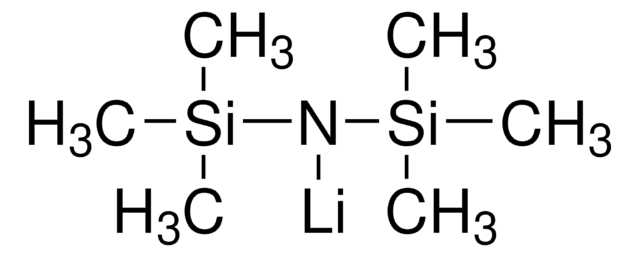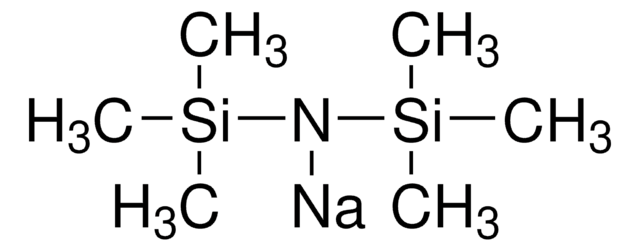すべての画像(1)
About This Item
化学式:
[(CH3)3Si]2NLi
CAS番号:
分子量:
167.33
Beilstein:
3567910
MDL番号:
UNSPSCコード:
12352111
PubChem Substance ID:
NACRES:
NA.22
おすすめの製品
形状
liquid
品質水準
濃度
1.5 M in THF
密度
0.893 g/mL at 25 °C
SMILES記法
[Li]N([Si](C)(C)C)[Si](C)(C)C
InChI
1S/C6H18NSi2.Li/c1-8(2,3)7-9(4,5)6;/h1-6H3;/q-1;+1
InChI Key
YNESATAKKCNGOF-UHFFFAOYSA-N
類似した製品をお探しですか? 訪問 製品比較ガイド
関連するカテゴリー
詳細
リチウムビス(トリメチルシリル)アミドは、通常、非求核性の強いBronsted(ブレンステッド)塩基として有機合成に使用されます。本製品は、芳香族炭化水素、ヘキサン、THFなどのほとんどの非極性溶媒に溶けます。
アプリケーション
リチウムビス(トリメチルシリル)アミドは、以下の試薬として使用できます:
- 脱プロトン化および求核的ジフルオロメチル化反応。
- N-トリメチルシリル化イミンのin situ生成を介してアルデヒドおよびリチウム化メトキシアレンと反応させることによる3-メトキシ置換ジヒドロピロール誘導体。
- Darzens縮合反応と有向アルドール縮合反応。
- 4-オクチルアミノ安息香酸メチルエステルの連鎖成長重縮合によるポリ(N-オクチル-p-ベンズアミド)の合成。
シグナルワード
Danger
危険有害性の分類
Carc. 2 - Eye Dam. 1 - Flam. Liq. 2 - Self-heat. 1 - Skin Corr. 1B - STOT SE 3
ターゲットの組織
Central nervous system, Respiratory system
補足的ハザード
保管分類コード
4.2 - Pyrophoric and self-heating hazardous materials
WGK
WGK 2
引火点(°F)
31.3 °F - closed cup
引火点(℃)
-0.4 °C - closed cup
適用法令
試験研究用途を考慮した関連法令を主に挙げております。化学物質以外については、一部の情報のみ提供しています。 製品を安全かつ合法的に使用することは、使用者の義務です。最新情報により修正される場合があります。WEBの反映には時間を要することがあるため、適宜SDSをご参照ください。
PRTR
第一種指定化学物質
消防法
第4類:引火性液体
第一石油類
危険等級II
非水溶性液体
労働安全衛生法名称等を表示すべき危険物及び有害物
名称等を表示すべき危険物及び有害物
労働安全衛生法名称等を通知すべき危険物及び有害物
名称等を通知すべき危険物及び有害物
Jan Code
766917-800ML:4548173332994
766917-BULK:
766917-100ML:4548173332987
766917-VAR:
この製品を見ている人はこちらもチェック
Nan Li et al.
Lab on a chip, 8(12), 2105-2112 (2008-11-22)
High-density live cell array serves as a valuable tool for the development of high-throughput immunophenotyping systems and cell-based biosensors. In this paper, we have, for the first time, demonstrated a simple fabrication process to form the hexamethyldisilazane (HMDS) and poly(ethylene
Tatsuya Nitabaru et al.
Journal of the American Chemical Society, 131(38), 13860-13869 (2009-09-10)
Full details of an anti-selective catalytic asymmetric nitroaldol reaction promoted by a heterobimetallic catalyst comprised of Nd(5)O(O(i)Pr)(13), an amide-based ligand, and NaHMDS (sodium hexamethyldisilazide) are described. A systematic synthesis and evaluation of amide-based ligands led to the identification of optimum
Juliana Tsz Yan Lee et al.
Scanning, 34(1), 12-25 (2012-04-26)
Common dehydration methods of cells on biomaterials for scanning electron microscopy (SEM) include air drying, hexamethyldisilazane (HMDS) or tetramethysilane (TMS) treatment and critical point drying (CPD). On the other side, freeze-drying has been widely employed in dehydrating biological samples and
Xiaoguang Li et al.
Chemical communications (Cambridge, England), 47(38), 10761-10763 (2011-08-30)
A silica microsphere suspension and a silica sol are employed in a two-step dipping process for the preparation of a superhydrophobic surface. It's not only a facile way to achieve the lotus effect, but can also create a multi-functional surface
Werner Mormann et al.
Macromolecular bioscience, 9(4), 369-375 (2008-11-26)
Trimethylsilylation of cellulose in different 1,3-dialkylimidazolium ionic liquids (IL) with hexamethyldisilazane (HMDS) as a silylating agent was investigated. Trimethylsilyl (TMSi) cellulose with a degree of substitution (DS) greater than 1 is insoluble in the IL. The maximum DS obtained depends
ライフサイエンス、有機合成、材料科学、クロマトグラフィー、分析など、あらゆる分野の研究に経験のあるメンバーがおります。.
製品に関するお問い合わせはこちら(テクニカルサービス)












